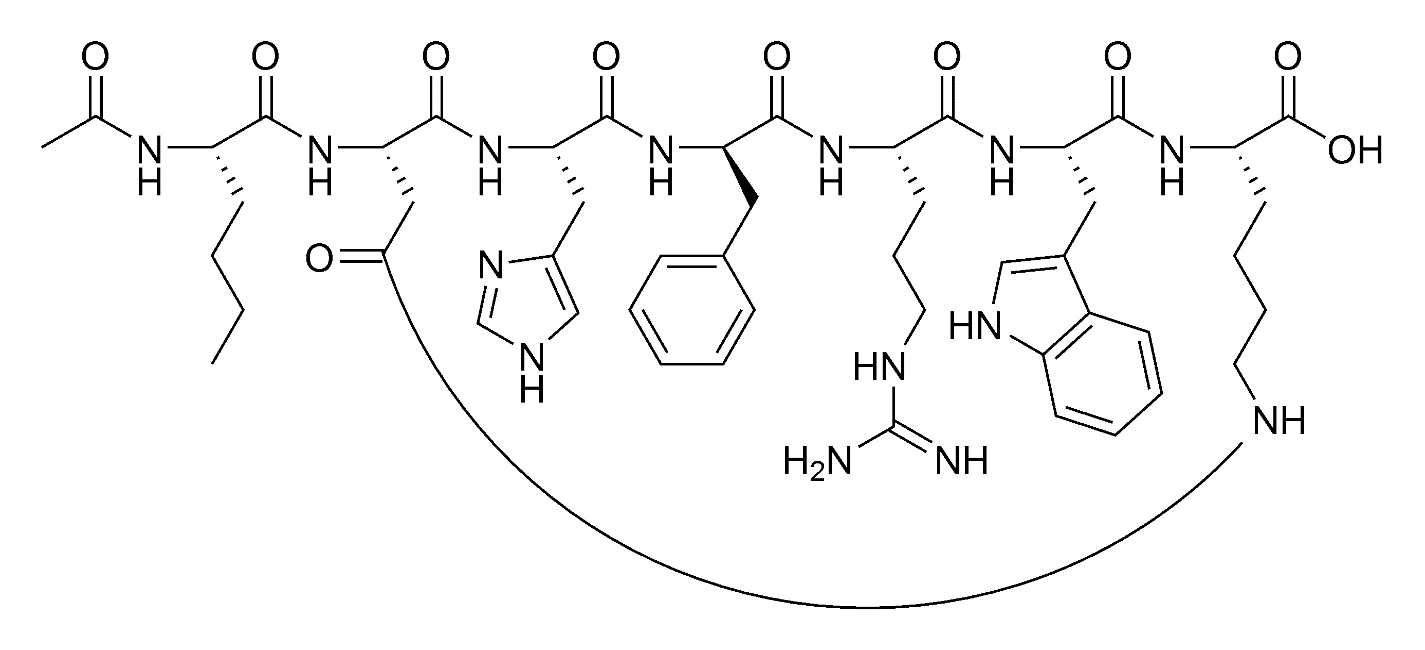Peptide for a beautiful mulatto

PT-141, which forever changed the idea of harem in eastern countries
The dry matter of all living organisms consists of about 90 percent of proteins, fats and carbohydrates. These are the biopolymers we eat. These same organisms use a protein constructor to exchange signals within the body, as one of the communication systems. If the signal is fast, the neural network can be used. If slow and affects large areas, a chemical stimulus can be used. Most of the substances used as a kind of “information agent” have a peptide nature. The most interesting among them are hormones – they are also peptides for the most part.
Hormones are good because any body can process them quickly. They are quickly removed when they are no longer needed. Therefore, now that science has more or less understood how it works, magic begins to open.
One of the first mass peptides was Bremelanotide (PT-141), known as “Viagra for Women”. The problem with him is that the safety tests ended at the moment when the connection was available on the market for seven years in a row. The effect is complex: it is used in sports, it darkens the skin (tanning effect) and significantly increases female libido, it is used to correct desire and erection in men.
Then it started in cosmetics. Why is it important to use peptides after testing and strictly for their intended purpose – because there have been cases of the discovery of compounds that remarkably smooth wrinkles of the skin. Only nine out of ten test sheep died of asphyxiation. But smooth as babies.
Chemical commands to the body
As soon as scientists figured out how hormonal signals work, there was a temptation to imitate nature and use its language to give commands to the body. As you know, it was difficult to resist him. First, they began to collect peptides similar to those in the body and check what effects it gives.
A peptide is information for cells what to do. More than 30 years ago, when all this was just discovered, they did not know how to specifically study them. There were no methods for accurate analysis, there was no selective synthesis in laboratories. But 30 years ago, technology and research and precision production appeared. And away we go.
In principle, you can take almost any regulatory mechanism that a person has, and use peptide components (similar to natural hormones) to act in one or the other direction.
Insulin can instantly kill or fine-tune glucose. Angiotensin changes the size of capillaries and affects pressure. Etc.
At first, hormonal drugs were used in medicine: production was expensive, but the effect and purpose were visible. The first attempts were understandable: we take a broken system of the body and try to decide which bioregulators can compensate for its effect. We make analogues. Everything is under control in the farm, long research and thorough justification of each step.
There was a massive way to make synthetic peptides similar to natural ones. It was not necessary to poke around and build a molecule from scratch, you could just produce what is already in the body. There was a peptide boom. Over the past ten years, several thousand drugs have appeared on the market. This is about 5% of the entire pharmaceutical market (in assortment).
Since the pharmacy “dispersed” the peptide market, they began to drop in price sharply, because they were made almost in garages with bioreactors. China pulled itself up and mastered technology, equipment and material became much more affordable.
Cosmetics
At some point, the finished peptides fell in price so much that they could be used in other areas. The first was veterinary medicine (there are snapped up any means that help to multiply and increase milk yield), the second is cosmetology.
If you look closely at cosmetic peptides, they do the same thing as ordinary ones. They affect the body and its cells in particular. The difference is that the effect is most often not systemic, not directed to the whole organism, but more often local. The peptide in the composition of the product is applied to the skin, skin cells receive signals (you need to change the connection with other cells, for example – then the skin is smoothed). The peculiarity is that in cosmetics the regulation is not the same as in the pharmaceutical market. Eight to ten years for medicine or six months for cosmetics – there is a difference in the speed of entry into the market. And just everyone rushed there. Currently in European Consulate Cosmetics List There is a regulatory body – a company that registers all the ingredients for cosmetics. There at the moment of all components there are three thousand different peptides (almost 10% of the entire range of cosmetic ingredients).
In Russia, about 50 peptides are used (and produced) in cosmetics. The rest simply do not go through the economy in the formula of means. At the same time, there are very few farms under the guise of cosmetics (far less than in the dashing years after the collapse of the USSR).
The meaning of cosmetics – a peptide is taken with proven effectiveness and safety and just gets pulled into a new tool. Six months of testing – and to the market. In the case of pharma, every new combination would have run in for years. As I have already said, Bremelanotide, which PT-141, has been used for a very long time in fact without proven safety.
What is good in peptides? They are synthesized simply. More precisely, it is very simple and cheap. No need to have secret technology – a million Chinese manufacturers are ready to supply you with anything. Synthetic peptides are close to natural molecules, they are considered a priori safer than other drugs. And not without reason. This is on the one hand. But on the other, it’s bad. Due to the lack of practical control, anything can be sold under the guise of an active drug. In the general case, you can get just sugar, and it will sell normally. But in case of production errors, there will be not quite pure compounds (causing interesting side effects). But in a very bad situation, there may be an impurity that is clearly harmful to the body. Remember those very heroic sheep.
A significant part of manufacturers in practice use peptides from unofficial sources. What is brought from Alibaba must be controlled. If you are not a large company with a large RnD, then there will be no normal control inside. Bad manufacturers take advantage of this. They simply do not report and sell poorly clean products. Or under the guise of one product, another similar, but cheaper in synthesis. Not uniquely dangerous, but this is a systemic quality problem in the entire cosmetics market.
Ahhh, are we all going to die?
This is mandatory, but most likely not from cosmetics. It is important to understand that if a manufacturer can control the quality of production, then everything will be in order (most likely). If it cannot, the output of bullshit of varying degrees of effectiveness and danger.
Where do peptides make?
At the Russian peptide factory. Organikum grew out of the Institute of Biochemistry. A group of specialists from the institute created a peptide plant to solve applied problems. Many of these people at the same time work at the institute to solve scientific problems. And our cozy laboratory began its journey with the Scientific Research Institute of Medpolymers (more precisely, its remains).
The plant is able to make already known peptides and assemblies of new ones. The main direction of RnD is the development of technologies for producing peptide compounds.
In Russia, there are several companies that seek to obtain high-quality peptide components for their products, because they use them in their own developments in one way or another. We are one of these companies. The plant is convenient in that it allows you to get a controlled result with a clear internal process.
One of the main peptides that we buy is argireline. It can be bought in the form of a solution from Spain (it comes with preservatives), or transported from China. By the way, transporting and storing peptides is a separate quest, and there the quality of raw materials can also change significantly.
We order a dry batch in Russia in a capsule dosed exactly to the reactor. This is a very convenient form of production for production. No adverse reactions – one sterile ampoule per reactor. No oxidation, no interactions with the environment.
What can peptides in cosmetics?
Argireline is used in our Miorelax serum and in a gel with a similar BTA effect. In fact, the peptide is a myoblocker that blocks muscle innervation due to competitive inhibition of proteins that are involved in the conduction of a nerve impulse. That is, it weakens the signals of mimic activity when applied topically. If botox (botulinum toxin) simply paralyzes muscle tissue, then argirelin, greatly simplifying it, does not touch the cell mechanics itself, but intercepts signals for contractions. The result is a Botox effect without all the joy of paralysis from botulinum toxin. Plus, there are other components in the composition of the products that nourish and try to restore the skin relaxed at this moment. Botox cuts muscles, and this peptide relaxes. The effect is not so long and not so evil and lasts for several hours.
In general, in cosmetics there are many options for working with peptides. You can do as ours – smeared on the face, it smoothed out. In addition, there are peptides that are generally aimed at improving skin turgor, so that it is less flabby, less porous, there are stimulating metabolism and regeneration. There are cosmetic peptides for working with pigment, that is, those that add pigmentation or remove. This is not paint in the truest sense of the word, but signals that tell keratinocytes (epidermal cells) to reduce pigment production or increase.
The signals can be different. Roughly speaking, there is always a choice: to reduce wrinkles in general, to reduce wrinkles under the eyes, to improve the condition of the skin as a whole on the basis of the “ideas” of the body about self-regulation, but there are directed commands – make it drier, make it smoother, and so on.
This is very good, because when controlling raw materials it gives a quick opportunity to assemble new safe cosmetics from Lego (when peptides are used from the list and not new ones are created). And, I repeat, it’s bad that now the control of raw materials is put in practice quite poorly for many.
What’s next?
Further crop production. Plants use the same signaling principles, only they do not have a nervous system. For crop production, the peptide boom is just beginning, and if everything goes as it should, then we can expect further cheaper production of peptides — and an increase in the number of peptide cosmetics.
So now you can roughly imagine how and where you can buy a couple of teams for your body. Use this power with caution, Jedi.
Drop by us at telegram channel or @geltek_cosmetics. There are many interesting stories about the chronicles of our cozy laboratory.





